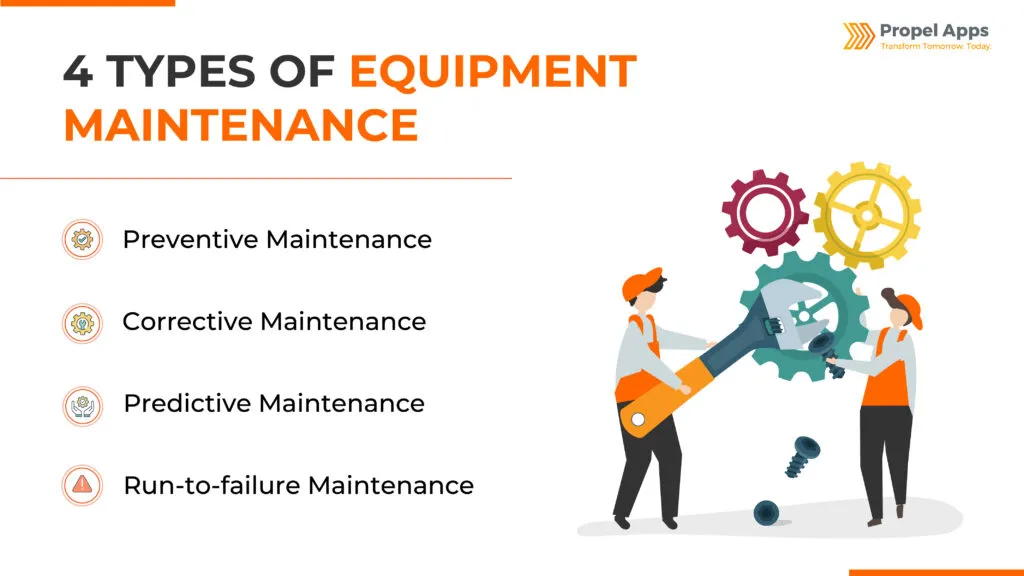
In the modern industrial landscape, equipment maintenance plays a crucial role in ensuring operational efficiency, safety, and profitability. From manufacturing plants to healthcare facilities, the smooth functioning of equipment is vital for maintaining productivity and delivering quality outcomes.

This blog delves into the best practices and tips for building a robust equipment maintenance strategy, highlighting its importance across various industries and the benefits it brings.
Equipment maintenance encompasses the activities undertaken to keep machinery and equipment in optimal working conditions. This involves routine inspections, servicing, repairs, and replacements to prevent breakdowns and prolong the lifespan of the equipment. Maintenance can be planned, preventive, or predictive, depending on the needs and conditions of the equipment.
Various assets necessitating regular maintenance include vehicle fleets, IT infrastructure, tools, construction machinery, industrial equipment, manufacturing apparatus, and other critical resources essential for your equipment maintenance strategy and business operations.
Equipment maintenance is of different types, based on the criticality, priority, and the type of equipment that needs to be maintained. The most common and prevalent types of equipment maintenance are as follows:

Preventive maintenance involves scheduled activities designed to proactively address potential issues, ensuring equipment operates efficiently and reducing the likelihood of unexpected breakdowns. A solid equipment maintenance strategy includes preventive measures to extend the lifespan of assets, improve safety, and minimize costly downtime.
Predictive maintenance involves using real-time data and predictive analytics to monitor equipment condition and anticipate failures before they occur. When integrated into your equipment maintenance strategy, predictive maintenance helps businesses optimize resources and cut down on unplanned downtime.
Corrective maintenance, also referred to as reactive maintenance, is carried out after a fault is detected, aiming to restore equipment to its proper functioning state. While not the ideal default, incorporating corrective practices into your equipment maintenance strategy ensures prompt responses to unanticipated issues.
A run-to-failure equipment maintenance strategy involves allowing equipment to operate until it breaks down before performing any repairs. This strategy is ideal for non-critical equipment where maintenance costs outweigh the risk of failure.
Though all asset-intensive industries require equipment maintenance, it is particularly crucial in industries that heavily rely on optimal asset functioning.
An effective equipment maintenance strategy provides several key benefits for organizations across various sectors.
Regular maintenance prevents accidents caused by equipment failures, protecting workers and users.
Scheduled maintenance detects issues early, significantly reducing repair costs—a fundamental goal of any efficient equipment maintenance strategy.
Reliable equipment encourages high productivity. A proactive equipment maintenance strategy ensures machines function as intended, reducing energy waste and inefficiency.
Predicting and preventing breakdowns helps companies maintain production schedules, a cornerstone of any solid equipment maintenance strategy.
Routine servicing and timely repairs help prevent escalation of minor issues into major problems, an essential aspect of maximizing asset lifespan through a proper maintenance strategy.
Adhering to scheduled maintenance ensures regulatory compliance, making it a critical part of any industry-specific maintenance strategy.
Timely delivery of goods and services directly depends on equipment reliability, which is a direct reflection of how effective your organization’s equipment maintenance strategy is.
The following are the key job roles that are activity involved in equipment maintenance:
A successful maintenance strategy for your equipment is built on a few best practices as follows:
Mobile ERP maintenance solutions have revolutionized how teams implement an equipment maintenance strategy, offering real-time access to schedules, tools, and status updates. Here are some of the key benefits:
For organizations using Oracle or SAP, Propel Apps’ mobile asset maintenance solution integrates with your ERP system to enhance plant maintenance efficiency. Explore the solution to transform your equipment maintenance strategy and schedule a free demo.
An effective equipment maintenance strategy is essential for minimizing costs, extending equipment lifespan, and ensuring operational safety. Whether preventive, predictive, or corrective, your strategy should align with organizational goals and industry regulations.
By leveraging mobile technology and adopting best practices, companies can enhance equipment reliability and reduce downtime—key steps in executing a successful, long-term equipment maintenance strategy.